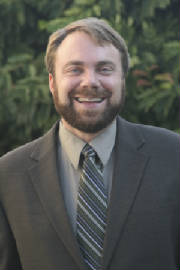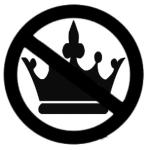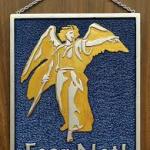
Though this is the last lesson, I hope that this primer on Islam has only made you more hungry to understand and engage this world religion. Ten years ago, after the tragic events of 9-11, I began to teach the beginnings of the material I’ve here shared with you. I hope you will find it useful. I find my own Christian faith strengthened as I try to understand the faith and thought world of Islam. It is in humility and love that I declare Christ my Lord, and it is with such confidence that I work to care for this world. All of it.
Lesson six offers the context of the often forgotten beginnings of Islam in North America. Largely through the slave trade, Islam would enter this continent, and would be shaped by subsequent groups of immigrants who would proudly call America “home.” Some practical points concerning dialogue with Muslims is offered as well as further resources. God bless you in your walk of faith and discovery of Christ in your midst.
A Primer on Islam
Lesson Six: Muslims in North America
by Pastor Bob
Transatlantic Slave Trade
- The enslavement of Native Americans occurred early on but was soon supplanted by slaves brought from Africa
- It is estimated that roughly 11 million African slaves arrived in the Americas and that likely some 8 or more million died beforehand
- Driven by a number forces including inter-African kingdom warfare, European pressure and greed, millions of Africans were captured largely in Western and Central Africa and brought to ports where they were held in huge forts called “factories” and sent to the Americas
- Ships sailing the “Middle Passage” usually took 2½ months to cross and at least 13% of the total deaths occurred at sea
- “Seasoning camps” for slaves mainly going to Central and South America were meant to break their spirits like animals before they were then sent to the plantations, etc.
- Economics: The raising and labor intensive processing of sugar likely accounts for some 70% of the slaves taken from Africa (35% of all slaves going to Brazil, 4.4% to North America). The raising of coffee, cotton and tobacco were other major crops.
- The Portuguese were early practitioners of the transatlantic slave trade followed by the Spaniards, the French, the Dutch and the British whose domination of the seas would lead to its economic and military dominance in the world
- Britain would then ironically lead the world in the abolishment of slavery
Early Islam in the United States
- Slavery brought many African Muslims to America and after the War of Independence, Muslims numbered around 15-20% of the slave population due to a preference for slaves from Muslim Senegambia (West Africa).
- Muslims brought from Africa ranged from the highly educated and socially situated to the more ordinary members of the Muslim community. Only a small number of their stories have been handed down to us, but here are a few examples:
- Kunte Kinta: Known from Alex Haley’s book and television mini-series, Roots, Kunte Kinta was a Muslim taken from Senegambia and sent to America as a slave.
- Abdul Rahahman: A military leader and well-educated Muslim scholar of the Fulbe or Fulani people of West Africa, Rahahman was ambushed in 1788 and sold to the British who brought him to America and sold him to a Louisiana farmer. The American Colonization Society (ACS) took an interest in Rahahman and envisioned him as a great missionary to West Africa. Rahahman impressed the ACS by writing what he said was the Lord’s Prayer in Arabic and later raised enough money to purchase his family’s freedom under the guise of evangelizing Muslims in Africa. Once back in Africa, Rahahman to the disappointment of the ACS resumed his Islamic faith and it turned out that the Lord’s Prayer he had written in Arabic was actually the fatiha, the first sura of the Qur’an!
- Bilali: Like Rahahman, Bilali was a Fulbe from Timbo and an accomplished Islamic scholar. During America’s second war with England (1813), Bilali was put in charge of 80 armed slaves and pledged to defend the Selapo Island of Georgia. He said to his master that he would defend the island if attacked and that he could “answer for every negro of the true faith, but not for the Christian dogs you own.”
- Job Ben Solomon: A slave who wrote at least two copies of the Qur’an from memory.
- A kind of syncretistic stage also occurred as Christians sought to proselytize Muslims. In 1842, a Christian preacher from Georgia, Reverend Charles Colcock Jones, commented that slaves in his district “have been known to accommodate Christianity to Mohammedanism. ‘God,’ they say, ‘is Allah, and Jesus Christ is Mohammad—the religion is the same, but different countries have different names.’”
- Given the oppressive conditions, it is not surprising that Muslim communities were unable to go beyond being isolated pockets of people with little formal organization.
Emergence of Black Islamic Theologies of Liberation in the 20th Century
- With the twentieth century, competing organizations of Muslim African Americans arose which viewed Islam as a vehicle for freedom—fusing Islam with nationalism
- Though showing distinct differences, they shared several characteristics:
- They argued that Islam was the natural religion of the black person
- That Islam was the pristine religion from Africa
- That African Americans were the Chosen People
- Islam not only provided a religious and cultural heritage, but both dignity and a destiny.
Moorish Science Temple: Established in 1913 by Noble Drew Ali
- Noble Drew Ali, born Timothy Drew (1886-1929), was influenced by Marcus Garvey’s Universal Negro Improvement Association (UNIA), which advocated the return to Liberia—back to the homeland of Africa
- Ali presented himself as the “Angel of Allah” claiming that during a pilgrimage to Africa the King of Morocco gave him permission to revert all African Americans back to Islam and their true Moorish American identity.
- He taught that the aboriginal black culture was the cradle of civilization, that the Muslim prophets were black sages, and that the original Moorish Empire encompassed all of Africa, Asia and the Americas before the continents separated. The Moorish civilization later began to crumble when it turned to other gods and principles of the white man. God then intervened for his Chosen People and sent the Moorish prophet Jesus who was then reincarnated as Muhammad and then Noble Drew Ali, himself.
- In 1927 the Moorish Science Temple published the Holy Koran, which was not actually the Qur’an but rather an esoteric work that supposedly held the contents of a Silent Brotherhood of Islamic sages. Its words describe the black person as the eternal, infinite thought of Allah, who temporarily was embodied but would later re-ascend into a perfect being and One with Allah.
- Economic independence for African Americans also became an important part of the goals of the Moorish Science Temple and a “Moorish Industrial Group” was formed to help operate small businesses such as barbershops and restaurants. It appears that internal conflict led to a key leader being killed and after Ali and others were gathered by the police as suspects, they were brutalized and few days after being released Ali died.
- Succession issues split the Moorish Science Temple into various factions and forms. A few of its members would later start the important Nation of Islam.
Nation of Islam: (Established in 1930 by Wallace Fard Muhammad)
- An American sect rejecting the core Muslim belief that Muhammad was the last prophet, believing that Elijah Muhammad (1897-1975) and now Louis Farrakhan are also prophets.
- Distancing itself further from mainstream Islam, the Nation of Islam espouses black supremacy—Islam believes that all races are equal in the eyes of God.
- Malcom X, a member of the Nation of Islam, rejected its black supremist doctrine after attending Hajj and was later assassinated. Elijah Muhammad’s own son, Warith Deen Muhammad, also rejected the black separatist views of his father and after taking over the Nation of Islam, he renamed it the American Society of Muslims (following mainstream Sunni doctrine).
- Louis Farrakhan and others who were enraged by the actions of Warith Deen Muhammad, separated themselves and again formed the “Nation of Islam” with its black supremist views and with Farrakhan as its prophet (though only a small minority compared to those who followed Warith Deen). Farrakhan helped organize the 1995 “Million Man March” in D.C.
Today
- The majority of African-American Muslims have followed Warith Deen Muhammad (who recently died) and participate in mainstream, Sunni Islam.
- Roughly 30% of Muslims in America are African-American, 25% of South-Asian origin, 25% of Arab and Persian origin, 15% other/mixed race, and 5% Latino.
- Numerous Muslim immigrant populations have also established communities and mosques, particularly in the Washington-Boston corridor, Dearborn, Houston and Southern California.
CHRISTIAN DIALOGUE WITH MUSLIMS
Two basic forms of “Dialogue”
- Inter-faith: External conversation between Christians and other religions such as Islam
- Intra-faith: Internal conversation among Christians regarding other religions
Interfaith Dialogue and Islam
- Social justice issues (Both the shared wisdom of each tradition and the strategic planning of human resources)
- Homelessness
- Immigration
- Healthcare
- Jubilee (Forgiveness of debt for poorer nations)
- Environmental concerns
- Spiritual or mystical commonalities
- Responding to terrorism
- Theologically
- Shared views of Jesus
- Shared views of the “prophets”
- What does the “Unity” of God mean?
- A Common Word (www.acommonword.com): Unity of God, Love of God, Love of Neighbor
- Divine power and the Muslim concept of ḥilm
Intra-faith Dialogue
- Intra-faith dialogue helps define Christian identity
- It is to look in the mirror of the other (but a related other)
- It forces one to explicitly define and prioritize positions
A FEW KEY POINTS TO REMEMBER ABOUT ISLAM
- Islam is not monolithic. Though Islam has many unifying elements, particularly its rituals, the Muslim community is quite diverse and complex in its doctrine, ethnicity, law and political structures, let alone geographical context.
- Muslims and Jews worship the same God (the God of Abraham) as Christians though there are distinct differences concerning the nature of God and God’s revelation to humanity. The exact nature of Jesus is disputed, but there is not doubt that both Muslims and Christians admire Jesus.
- Many Muslims view modern Western actions as a continuation of the Crusades and Colonization.
- As we relate to Muslims, particularly as Americans, it is important to remember that Islam is inherently concerned with equality. Americans however view equality in terms of individual rights and freedoms while Muslims view equality in terms of community.
- A post-modern world (or whatever label you care for) is experiencing renewed religious fervor, particularly within Islam and this movement needs to be comprehended by all.
SOME RESOURCES ON ISLAM
Books
John L. Esposito. Islam: The Straight Path, 3rd Ed. New York: Oxford University Press, 1998.
- Common introduction to Islam. Clear style. Good with modern Islam.
Fred Denny. An Introduction to Islam, 3rd Edition. Upper Saddle River, New Jersey: Pearson Prentice Hall, 2006.
- Very complete and has been used in many classrooms. A balanced voice.
Sachiko Murata & William C. Chittick. The Vision of Islam. New York: Paragon House, 2004.
- The best resource I have found for giving insight into the heart of Islam and how Muslims think about their faith. Importantly, the book has a Shi’a and Sufi orientation that both enriches and restricts its usefulness.
The Holy Qur’an. The Translation and Commentary by ‘Abdullah Yusuf ‘Ali. Brentwood, MD: Amana Corporation.
- An accepted translation of the Qur’an by Muslims. Has both the Arabic and English side by side on each page. Extensive, conservative commentary.
The Qur’an, a New Translation. Translation by Thomas Cleary. Starlatch Press, 2004.
- A fairly new translation that conveys the poetic nature of the Qur’an, yet gives an accurate translation that Muslims accept.
Abdullah Saeed. Islamic Thought—An Introduction. London: Routledge, 2006.
- A favorite of mine. Very clear, concise and accurate. Not too much jargon. Does not give historical detail or information on practical Muslim life.
Fazlur Rahman. Islam, 2nd Edition. Chicago: University of Chicago Press, 1979.
- Not elementary but a brilliant, insightful introduction that goes far beyond other introductions. It is a self-reflective look at Islam from a Sunni perspective and makes an excellent companion to Murata & Chittick’s book. This should not be read first!
Abou el-Fadl. The Search for Beauty in Islam: A Conference of the Books. Lanham, Md: Rowman and Littlefield, 2006.
- A brilliant Muslim jurist and professor at UCLA, he teaches courses on human rights and religious extremism. This book reflects his intellectual journey.
Tariq Ramadan. Western Muslims and the Future of Islam. New York: Oxford University Press, 2004.
- A reflective and honest rapprochement of Muslims in a Western intellectual context. It highlights opportunities for Muslims in the West and for the world.
Website
www.isna.com Islamic Society of North America
- Mainstream North American Islam with good articles, videos, etc.
Pastor Bob is a pastor in San Diego.
More in this series:
A Primer on Islam: The Basics (Lesson 1 of 6)
A Primer On Islam: Groups, Sects and Shari’a (Lesson 2 of 6)
A Primer on Islam: Historical Outline (Lesson 3 of 6)
A Primer on Islam: History Behind the News (Lesson 4 of 6)
A Primer on Islam: Muslims in Context (Lesson 5 of 6)
[Note to commenters: Be nice; be respectful; keep it extremely civil. Anything else will get you booted. Thanks for understanding.]









